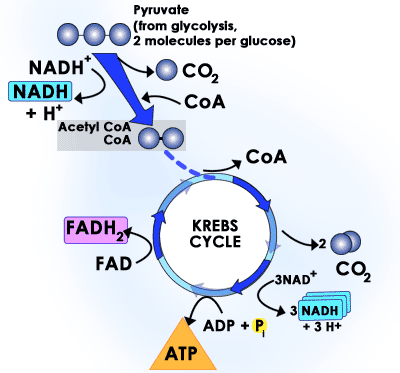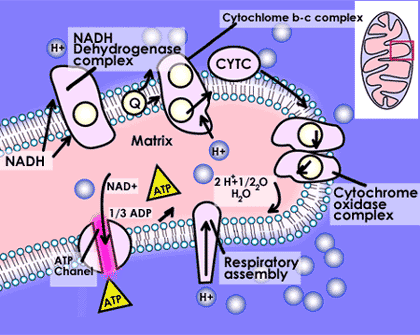Since all digestible forms of carbohydrates are eventually transformed into glucose, it is important to consider how glucose is able to provide energy in the form of adenosine triphosphate (ATP) to various cells and tissues. Glucose is metabolized in three stages:
- glycolysis
- the Krebs Cycle
- oxidative phosphorylation
Glycolysis
The breakdown of glucose to provide energy begins with glycolysis. To begin with, glucose enters the cytosol of the cell, or the fluid inside the cell not including cellular organelles. Next, glucose is converted into two, three-carbon molecules of pyruvate through a series of ten different reactions. A specific enzyme catalyzes each reaction along the way and a total of two ATP are generated per glucose molecule. Since ADP is converted to ATP during the breakdown of the substrate glucose, the process is known as substrate-level phosphorylation. During the sixth reaction, glyceraldehyde 3-phosphate is oxidized to 1,3 bisphosphoglycerate while reducing nicotinamide adenosine dinucleotide (NAD) to NADH, the reduced form of the compound. NADH is then shuttled to the mitochondria of the cell where it is used in the electron transport chain to generate ATP via oxidative phosphorylation, which will be described later.
The most important enzyme in glycolysis is called phosphofructokinase (PFK)and catalyzes the third reaction in the sequence. Since this reaction is so favorable under physiologic conditions, it is known as the "committed step" in glycolysis. In other words, glucose will be completely degraded to pyruvate after this reaction has taken place. With this in mind, PFK seems as if it would be an excellent site of control for glucose metabolism. In fact, this is exactly the case. When ATP or energy is plentiful in the cell, PFK is inhibited and the breakdown of glucose for energy slows down. Therefore, PFK can regulate the degradation of glucose to match the energy needs of the cell. This type of regulation is a recurring theme in biochemistry.
Krebs Cycle and Oxidative Phosphorylation/Electron Transport Chain
There are many compounds that are formed and recycled during the Krebs Cycle
(Citirc Acid Cycle). These include oxidized forms of nictotinamide adenine
dinucleotide (NAD+) and flavin adenine dinucleotide (FAD) and their reduced
counterparts: NADH and FADH2. NAD+ and FAD are electron acceptors and become
reduced while the substrates in the Krebs Cycle become oxidized and surrender
their electrons.

The Krebs Cycle begins when the pyruvate formed in the cytoplasm of the cell during glycolysis is transferred to the mitochondria, where most of the energy inherent in glucose is extracted. In the mitochondria, pyruvate is converted to acetyl CoA by the enzyme pyruvate carboxlase. In general, Acetyl-CoA condenses with a four carbon compound called oxaloacetate to form a six carbon acid. This six-carbon compound is degraded to a five and four carbon compound, releasing two molecules of carbon dioxide. At the same time, two molecules of NADH are formed. Finally, the C-4 carbon skeleton undergoes three additional reactions in which guanosine triphosphate (GTP), FADH2 and NADH are formed, thereby regenerating oxaloacetate. FADH2 and NADH are passed on to the electron transport chain (see below) that is embedded in the inner mitochondria membrane. GTP is a high-energy compound that is used to regenerate ATP from ADP. Therefore, the main purpose of the Krebs Cycle is to provide high-energy electrons in the form of FADH2 and NADH to be passed onward to the electron transport chain.
The high-energy electrons contained in NADH and FADH2 are passed on to a series
of enzyme complexes in the mitochondrial membrane.



 payment page
payment page



